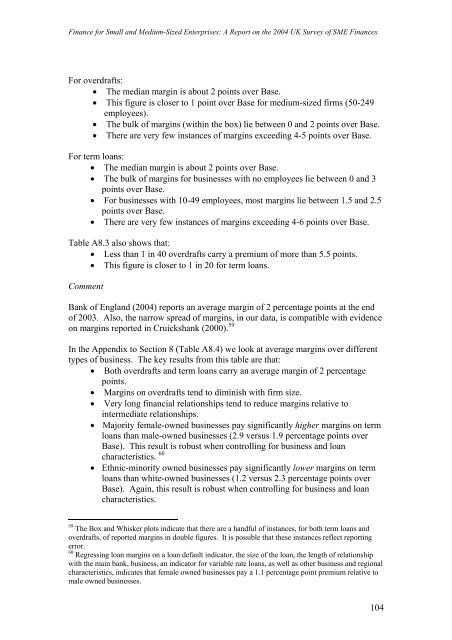Finance for Small and Medium-Sized Enterprises - DTI Home Page
Finance for Small and Medium-Sized Enterprises - DTI Home Page
Finance for Small and Medium-Sized Enterprises - DTI Home Page
Create successful ePaper yourself
Turn your PDF publications into a flip-book with our unique Google optimized e-Paper software.
<strong>Finance</strong> <strong>for</strong> <strong>Small</strong> <strong>and</strong> <strong>Medium</strong>-<strong>Sized</strong> <strong>Enterprises</strong>: A Report on the 2004 UK Survey of SME <strong>Finance</strong>s<br />
For overdrafts:<br />
• The median margin is about 2 points over Base.<br />
• This figure is closer to 1 point over Base <strong>for</strong> medium-sized firms (50-249<br />
employees).<br />
• The bulk of margins (within the box) lie between 0 <strong>and</strong> 2 points over Base.<br />
• There are very few instances of margins<br />
exceeding 4-5 points over Base.<br />
For term loans:<br />
• The median margin is about 2 points over Base.<br />
• The bulk of margins <strong>for</strong> businesses with no employees lie between<br />
0 <strong>and</strong> 3<br />
points over Base.<br />
• For businesses with 10-49<br />
employees, most margins lie between 1.5 <strong>and</strong> 2.5<br />
points over Base.<br />
• There are very few instances<br />
of margins exceeding 4-6 points over Base.<br />
Table A8.3 also shows that:<br />
• Less than 1 in 40 overdrafts carry a premium of more than 5.5 points.<br />
• This figure is closer to 1 in 20 <strong>for</strong> term loans.<br />
Comment<br />
Bank of Engl<strong>and</strong> (2004) reports an average margin of 2 percentage points at the end<br />
of 2003. Also, the narrow spread of margins, in our data, is compatible with evidence<br />
on margins reported in Cruickshank (2000). 59<br />
In the Appendix to Section 8 (Table A8.4) we look at average margins over different<br />
types of business. The key results from this table are that:<br />
• Both overdrafts <strong>and</strong> term loans carry an average margin of 2 percentage<br />
points.<br />
• Margins on overdrafts tend to diminish with firm size.<br />
• Very long financial relationships tend to reduce margins relative to<br />
intermediate relationships.<br />
• Majority female-owned businesses pay significantly higher margins on term<br />
loans than male-owned businesses (2.9 versus 1.9 percentage points over<br />
Base). This result is robust when controlling <strong>for</strong> business <strong>and</strong> loan<br />
characteristics. 60<br />
• Ethnic-minority owned businesses pay significantly lower margins on term<br />
loans than white-owned businesses (1.2 versus 2.3 percentage points over<br />
Base). Again, this result is robust when controlling <strong>for</strong> business <strong>and</strong> loan<br />
characteristics.<br />
59 The Box <strong>and</strong> Whisker plots indicate that there are a h<strong>and</strong>ful of instances, <strong>for</strong> both term loans <strong>and</strong><br />
overdrafts, of reported margins in double figures. It is possible that these instances reflect reporting<br />
error.<br />
60 Regressing loan margins on a loan default indicator, the size of the loan, the length of relationship<br />
with the main bank, business, an indicator <strong>for</strong> variable rate loans, as well as other business <strong>and</strong> regional<br />
characteristics, indicates that female owned businesses pay a 1.1 percentage point premium relative to<br />
male owned businesses.<br />
104















![Joint Report on Social Protection and Social Inclusion [2005]](https://img.yumpu.com/19580638/1/190x132/joint-report-on-social-protection-and-social-inclusion-2005.jpg?quality=85)
